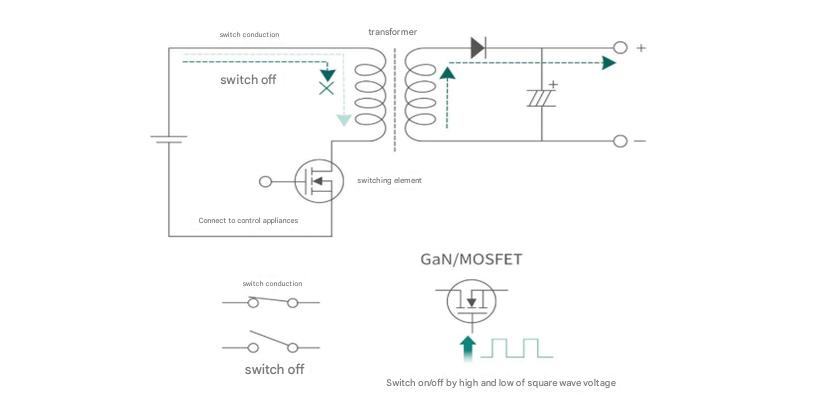The switching power supply is one of the core components in the charging process of modern electronic products. It ensures that the device can obtain the required power safely and quickly through efficient power conversion and precise voltage regulation. Compared with traditional linear power supplies, the switching power supply uses high-frequency switching technology (such as PWM pulse width modulation) to greatly improve energy efficiency and reduce energy loss. At the same time, it adapts to different input voltages (such as AC 220V or DC 12V) and outputs stable DC power to meet the precise requirements of mobile phones, laptops and other devices for charging voltage and current.
1. What is a switching power supply
Switch Mode Power Supply (SMPS), also known as switching power supply, switching converter, is a high-frequency power conversion device and a type of power supply. Its function is to convert a voltage of a certain level into the voltage or current required by the user through different forms of architecture. The input of the switching power supply is mostly AC power (such as mains) or DC power, and the output is mostly a device that requires DC power, such as a personal computer, and the switching power supply converts the voltage and current between the two.
During the charging process of electronic products, the switching power supply chops the input voltage into high-frequency pulses by turning on and off high-frequency switching devices, and then outputs a stable DC voltage after conversion by transformers and filter circuits. Specifically, the mechanism by which the switching power supply works during the charging process includes the following steps:
Input rectification and filtering : The AC input is first converted into pulsating DC through a rectifier bridge, and then a smoother DC is obtained through capacitor filtering .
High-frequency switching conversion : The switch tube (such as MOSFET) switches rapidly at a frequency of tens of kHz to MHz under PWM (pulse width modulation) control to chop the DC into a high-frequency square wave .
Voltage conversion : The high-frequency square wave is used to achieve voltage rise and fall through a high-frequency transformer (isolated type) or through inductor energy storage (non-isolated type) .
Output rectification and filtering : The secondary side uses fast recovery diodes or synchronous rectification technology for rectification, and then LC filtering to obtain a stable DC .
Feedback control : The output voltage adjusts the PWM duty cycle in real time through feedback circuits such as optocouplers to maintain output voltage stability .
2. Advantages of switching power supply in charging electronic products
High-efficiency energy conversion: Use high-frequency switching to reduce energy loss, and achieve voltage stabilization by adjusting the duty cycle rather than dissipating excess power, with an efficiency of 70-95%.
Small size: High-frequency transformers are dozens of times lighter than traditional transformers, making the charger smaller.
Less heat: Less heat when charging, unlike traditional chargers that feel hot to the touch.
Wide voltage adaptation: Able to adapt to various voltages of 100-240V, no need to bring a transformer when traveling abroad.
Safety isolation design: The input and output are completely separated by a transformer to ensure safe use.
3. How does the switching power supply play a role in the charging process of electronic products?
Let's take the most familiar mobile phone charger as an example to briefly introduce the working principle of the switching power supply, and at the same time sort out some common problems about the switching power supply for everyone.
As we all know, the AC power is transmitted from the power plant to thousands of households, and almost all electronic products need to use DC power. What happens in the process from high-voltage AC to low-voltage DC that meets the regulations of electrical appliances?
Simply put, the high-voltage AC in the socket is converted into stable DC through a rectifier and smoothing circuit; then it is converted into high-frequency pulses by using a switching power supply at high speed, and at the same time, the transformer drops the pressure; the current transmitted to the secondary coil of the transformer passes through a rectifier and smoothing circuit to become a stable low-voltage DC and is delivered to electronic products; in this process, the primary controller continuously detects the output feedback signal through optics and comparators to control the pulse width of the primary switch to meet the different charging needs of the mobile phone.
4. What is a rectifier and smoothing circuit?
Converting AC to DC is called rectification. In mobile phone chargers, a rectifier bridge composed of four diodes is usually used to rectify both directions of AC, which is called "full-wave rectification". The rectified DC still has the ripple voltage fluctuations of AC, so a capacitor is used to smooth it. The capacitor can accommodate the continuous incoming charge, and make the current smooth and stable in a charging and discharging manner.
5. What is the key to the light and efficient charger?
The answer is the switching element. The rectified DC is converted into high-frequency pulses (PWM waves) through the high-speed opening and closing of the switching element (GaN or MOSFET), and then turned back into AC.

6. What are common switching elements?
GaN and MOSFET are two common switching elements. MOSFET is the most common switching device, which has the characteristics of easy driving and high reliability. GaN is an emerging third-generation semiconductor technology in recent years. Compared with the traditional silicon-based MOS, it has excellent characteristics such as fast switching speed, high voltage resistance, low on-resistance, and small parasitic parameters. When applied to switching power supplies, it has the advantages of low loss and small overall solution size, which can improve the efficiency, power density and reliability of switching power supplies.

7. How does the transformer achieve energy transfer?
The core of the transformer is the magnetic element with coils on both sides, and the voltage changes with the number of coil turns. When there are more coils on the left and fewer coils on the right, the voltage changes from high to low. The high-frequency pulses on the primary line side are reduced to the voltage range that the mobile phone can withstand through the energy transfer of the transformer.
Because the current switching devices can achieve a switching frequency of up to several hundred KHz, the size of the transformer magnetic device can be greatly reduced, making the entire charger more portable and light.
8. What is a feedback circuit?
The most typical feedback circuit is to use an optocoupler to achieve electrical isolation between the primary and secondary sides. The feedback electrical signal on the secondary side is transmitted to the primary side through electricity->light->electricity, and then the comparator and PWM inside the primary side controller modulate the switch drive signal, thereby realizing the closed-loop regulation of the entire charger output.
The primary side controller will adjust the switch conduction duty cycle and switching frequency in real time through the feedback signal to adapt to different working conditions to achieve optimal efficiency. At the same time, the primary side controller will realize the safe operation of the charger through a variety of protection mechanisms. When an accident occurs, it can terminate the operation in time or try to self-recover over-temperature and over-voltage protection.
9. Loss parts of the switching power supply
The slight loss of each part of the switching power supply will have a greater impact on the overall power consumption.
The high frequency of switching power supply is its development direction. High frequency makes the switching power supply miniaturized and allows the switching power supply to enter a wider range of application fields, especially in the field of high-tech, which promotes the development of switching power supply. It develops in the direction of light, small, thin, low noise, high reliability and anti-interference with an annual growth rate of more than double digits. Switching power supply can be divided into two categories: AC/DC and DC/DC. DC/DC converters have been modularized, and the design technology and production process have been mature and standardized at home and abroad, and have been recognized by users. However, the modularization of AC/DC, due to its own characteristics, encounters more complex technical and process manufacturing problems in the process of modularization. In addition, the development and application of switching power supply are of great significance in saving energy, saving resources and protecting the environment.
Share our interesting knowledge and stories on social media













